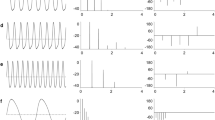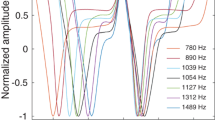Abstract
The sensory cues for a less known form of frequency shifting behavior, gradual frequency falls, of electric organ discharges (EODs) in a pulse-type gymnotiform electric fish, Rhamphichthys rostratus, were identified. We found that the gradual frequency fall occurs independently of more commonly observed momentary phase shifting behavior, and is due to perturbation of sensory feedback of the fish's own EODs by EODs of neighboring fish. The following components were identified as essential features in the signal mixture of the fish's own and the neighbor's EOD pulses: (1) the neighbor's pulses must be placed within a few millisecond of the fish's own pulses, (2) the neighbor's pulses, presented singly at low frequencies (0.2–4 Hz), were sufficient, (3) the frequency of individual pulse presentation must be below 4 Hz, (4) amplitude modulation of the sensory feedback of the fish's own pulses induced by such insertions of the neighbor's pulses must contain a high frequency component: sinusoidal amplitude modulation of the fish's own EOD feedback at these low frequencies does not induce gradual frequency falls. Differential stimulation across body surfaces, which is required for the jamming avoidance response (JAR) of wave-type gymnotiform electric fish, was not necessary for this behavior. We propose a cascade of high-pass and low-pass frequency filters within the amplitude processing pathway in the central nervous system as the mechanism of the gradual frequency fall response.
Similar content being viewed by others
Abbreviations
- EOD :
-
electric organ discharge
- f :
-
frequency of EOD or pacemaker command signal
- JAR :
-
jamming avoidance response
- S 1 :
-
stimulus mimicking fish's own EOD
- f 1 :
-
frequency of S1
- S 2 :
-
stimulus mimicking neighbor's EOD
- f 2 :
-
frequency of S2
References
Baker CLJ (1980) Jamming avoidance behavior in gymnotoid electric fish with pulse-type discharges: Sensory encoding for a temporal pattern discrimination. J Comp Physiol 136: 165–181
Bastian J (1976) Frequency response characteristics of electroreceptors in weakly electric fish (Gymnotoidei) with a pulse discharge. J Comp Physiol 112: 165–180
Bullock TH (1982) Electroreception. Annu Rev Neurosci 5: 121–170
Bullock TH, Hamstra RH, Scheich H (1972a) The jamming avoidance response of high frequency electric fish. I. General features. J Comp Physiol 77: 1–22
Bullock TH, Hamstra R H, Scheich H (1972b) The jamming avoidance response of high frequency electric fish. II. Quantitative aspects. J Comp Physiol 77: 23–48
Caputi A, Macadar O, Trujillo-Cenóz O (1994) Wave-form generation in Rhamphichthys rostratus (L) (Teleostei, Gymnotiformes). J Comp Physiol A 174: 633–642
Hagedorn M (1988) Ecology and behavior of a pulse-type electric fish, Hypopomus occidentalis (Gymnotiformes, Hypopomidae), in a fresh-water stream in Panama. Copeia 1988: 324–335
Hagiwara S, Kusano K, Negishi D (1962) Physiological properties of electroreceptors of some gymnotids. J Neurophysiol 25: 430–449
Heiligenberg W (1974) Electrolocation and jamming avoidance in a Hypopygus (Rhamphichthyidae, Gymnotoidei), an electric fish with pulse-type discharges. J Comp Physiol 91: 223–240
Heiligenberg W (1977) Principles of electrolocation and jamming avoidance in electric fish — A neuroethological approach. Springer, Berlin/Heidelberg New York
Heiligenberg W (1980) The evaluation of electroreceptive feedback in a gymnotoid fish with pulse-type electric organ discharges. J Comp Physiol 138: 173–185
Heiligenberg W (1991) Neural nets in electric fish. The MIT Press, Cambridge, MA
Heiligenberg W, Bastian J (1980) The control of Eigenmannia's, pacemaker by distributed evaluation of electroreceptive afferences. J Comp Physiol 136: 113–133
Heiligenberg W, Baker C, Bastian J (1978) The jamming avoidance response in gymnotoid pulse-species: a mechanisms to minimize the probability of pulse-train coincidence. J Comp Physiol 124: 211–224
Hopkins CD (1981) The neuroethology of electric communication. Trends Neurosci January: 4–6
Hopkins CD (1988) Neuroethology of electric communication. Annu Rev Neurosci 11: 497–535
Hopkins CD (1991) Hypopomus pinnicaudatus (Hypopomidae), a new species of gymnotiform fish from French Guiana. Copeia 1991: 151–161
Kawasaki M (1993) Comparative studies on the motor control mechanisms for electro-communication in gymnotiform fishes. J Comp Physiol A 173: 726–728
Kawasaki M, Heiligenberg W (1989) Distinct mechanisms of modulation in a neuronal oscillator generate different social signals in the electric fish Hypopomus. J Comp Physiol A 165: 731–741
Mago-Leccia F (1994) Electric fishes of the continental waters of America. Fudeci, Caracas
Mago-Leccia F, Zaret T (1978) Taxonomic status of Rhabdolichops troscheli (Kaup 1856), and speculations of gymnotiform evolution. Env Biol Fishes 3: 379–384
Scheich H, Gottschalk B, Nickel B (1977) The jamming avoidance response in Rhamphichthys rostratus: An alternative principle of time domain analysis in electric fish. Exp Brain Res 28: 229–233
Szabo T, Fessard A (1974) Physiology of electroreceptors. In: Fessard A (ed) Handbook of Sensory Physiology, vol. III/3 Springer, Berlin/Heidelberg New York, pp 13–58
Watanabe A, Takeda K (1963) The change of discharge frequency by A.C. stimulus in a weakly electric fish. J Exp Biol 40: 57–66
Westby GWM (1975) Has the latency-dependent response of Gymnotus carapo to discharge-triggered stimuli a bearing on electric fish communication? J Comp Physiol 96: 307–341
Author information
Authors and Affiliations
Rights and permissions
About this article
Cite this article
Kawasaki, M., Prather, J. & Guo, Y.X. Sensory cues for the gradual frequency fall responses of the gymnotiform electric fish, Rhamphichthys rostratus . J Comp Physiol A 178, 453–462 (1996). https://doi.org/10.1007/BF00190176
Accepted:
Issue Date:
DOI: https://doi.org/10.1007/BF00190176




